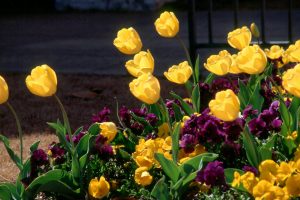Best way to care for spring bulbs after flowers are gone
By Ken Johnson University of Illinois Extension Services — May 6, 2022
Spring-blooming bulbs last for a few weeks. They can be fertilized once they are done blooming, although the best time to fertilize is when plants begin to emerge, according to horticulture educator Ken Johnson. (Photo courtesy of Mississippi State University)
Our days are getting longer and warmer, and many gardens are awash in color from spring-blooming bulbs like daffodils and tulips. Unfortunately, the blooms will eventually fade, leaving many of us wondering what we can do to help make sure that they are ready to go again next year.
Leave the leaves
The most important thing you can do to help your bulbs is to leave the foliage on the plants. The leaves are needed so the plants can photosynthesize and produce the food that the bulbs need to form flower buds for next year. If the foliage is removed or mowed too early, it can result in a smaller, weaker bulb that will gradually decline and die out.
Leave the foliage on the plants until it begins to yellow and dieback. It can then be removed because it will no longer produce food for the plants. For smaller bulbs like snowdrops and squill, this will happen relatively quickly. For larger plants, like tulips and daffodils, it can take several weeks for the foliage to die back on its own.
One problem with letting foliage remain is that it can become unsightly over time. In an attempt to make their gardens look tidier, many people will tie their foliage together to make it less noticeable. However, this is not recommended because doing this will reduce the amount of light the leaves can intercept, reducing the amount of photosynthesis, which leads to less energy produced by the plant.
As an alternative to tying up foliage, you can try to hide it. Consider interplanting annuals with your bulbs to help hide the foliage. You can also incorporate perennials like hostas in with your bulbs. Cornell University has conducted trials to see what combination of bulbs and perennials work well together. In addition to helping hide foliage, interplanting can also help extend the bloom season in your beds.
Deadhead your plants
While we don’t want to remove the leaves, it’s a good idea to remove spent flowers from plants to prevent the formation of seedpods. If plants are allowed to produce seeds, this will use energy that could otherwise be used for the bulbs and often result in smaller bulbs.
If you wish to save seeds from your bulbs allow the seed pods to develop. Many bulbs are hybrids, so seeds likely won’t be true to type (they can also be cross-pollinated). You’ll also need some patience, it can take several years for plants to bloom that are grown from seed. For example, it can take 5+ years for tulips and daffodils to grow from seed to bloom.
Fertilize your bulbs
Spring-blooming bulbs can be fertilized once they are done blooming, although the best time to fertilize is when plants begin to emerge. Look for a fertilizer high in phosphorous (middle number) and low in nitrogen (first number), such as a 5-10-5. Fertilizers are generally applied at 1-2 pounds per 100 square feet. Make sure to gently work or water the fertilizer into the soil. If you are unsure if you need to fertilize, conduct a soil test.
Crowded plants and fewer blooms
After several years you may notice that your bulbs are producing smaller or fewer flowers. This often happens when they become crowded. Bulbs will often reproduce by division, where new ‘daughter’ bulbs form from the original ‘mother’ bulb, causing plants to become crowded. If this happens, bulbs can be dug and divided once the foliage has died back and the bulbs are dormant.
Carefully dig around the bulb cluster and lift it out of the soil. Clean soil off of the bulbs so you have a good view of them. Separate bulbs by gently twisting and pulling the ‘daughter’ bulbs and dispose of any that are damaged or soft. Bulbs can then be replanted immediately, or they can be dried and stored in a cool place to be planted in the fall. Smaller bulbs may take a year or two to begin blooming.
Ken Johnson is a horticulture educator with the University of Illinois Extension Services







